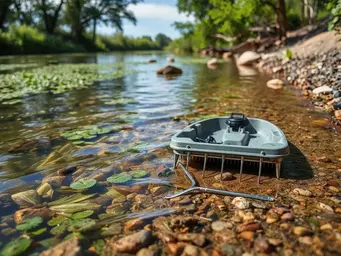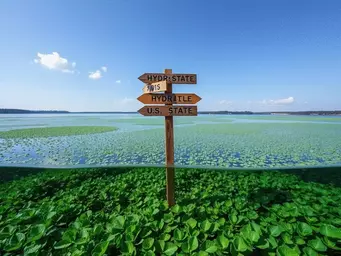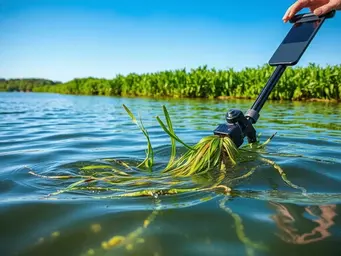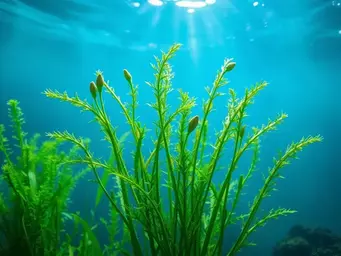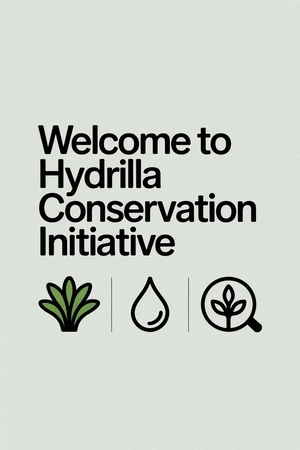Have you ever seen an aquatic plant take over a local waterway, turning it into a choking mass of greenery? Hydrilla is not just any plant; it’s a formidable invader threatening our ecosystems. Understanding how to manage this invasive species is crucial for the health of our waterways. Here are the essential insights you'll gain from our exploration of chemical control methods in hydrilla management.
What You Will Learn
- Hydrilla can significantly reduce biodiversity, disrupt oxygen levels, and alter water flow in aquatic ecosystems.
- Chemical control methods can provide rapid, targeted, and long-term solutions for managing dense hydrilla populations.
- Conducting a cost-benefit analysis is vital to understanding the ecological impacts of herbicide use versus alternative control methods.
- Sustainable management of hydrilla requires a holistic approach, integrating community involvement and various control strategies.
Hydrilla Control Strategies: A Comparative Overview
This visual outlines key aspects of Hydrilla's impact and the effectiveness of chemical control methods, balancing immediate action with long-term ecological considerations.
Impacts of Hydrilla on Aquatic Ecosystems
- Reduced Biodiversity
- Oxygen Depletion
- Altered Water Flow
Benefits of Chemical Control
- Rapid Action on infestations
- Targeted Treatment with specific herbicides
- Supports Long-term Management
Considerations for Herbicide Use
- Initial application costs
- Long-term ecological effects
- Potential for herbicide resistance
- Impact on non-target species
Holistic Management Components
- Regular monitoring
- Community involvement
- Utilizing IPM techniques
- Addressing Eutrophication
Chemical Control of Hydrilla: An Overview of Effective Herbicide Use
Managing hydrilla (Hydrilla verticillata) effectively requires an understanding of its nature and the best practices for control. This aquatic plant, while seemingly innocuous, can wreak havoc on local ecosystems, choking waterways and outcompeting native species. As an aquatic biologist, I’ve witnessed firsthand the detrimental effects of hydrilla on our precious aquatic habitats. But don’t worry—there are effective strategies to combat this invader!

To tackle hydrilla infestations, we first need to grasp its biology and ecological impact. When hydrilla proliferates, it can lead to decreased oxygen levels in the water, affecting fish and other aquatic life. This disruption can create a ripple effect throughout the ecosystem, stemming from its rapid growth and ability to thrive in various water conditions. Are you ready to learn how we can use chemical control methods as a critical part of our management strategy?
Understanding Hydrilla (Hydrilla verticillata) and Its Impact on Aquatic Ecosystems
Hydrilla is often described as one of the most invasive aquatic plants in North America. Its ability to spread quickly makes it a serious threat to local biodiversity. Here are some key impacts of hydrilla on aquatic ecosystems:
- Reduced Biodiversity: Native plants and fish populations struggle to survive in dense hydrilla environments.
- Oxygen Depletion: As hydrilla grows, it can reduce oxygen levels, leading to fish kills and habitat loss.
- Altered Water Flow: Its dense mats can interfere with water navigation and increase sedimentation. For more detailed information on its impacts, you can refer to resources from the Rhode Island Department of Environmental Management.
Understanding these impacts is essential for implementing effective control measures. Remember, recognizing the problem is the first step toward finding a solution!
The Importance of Chemical Control in Managing Hydrilla Infestations
Chemical control plays a vital role in managing hydrilla infestations, particularly when populations become dense and other methods prove ineffective. By utilizing carefully selected herbicides, we can effectively reduce hydrilla growth and promote the regrowth of native aquatic species. It’s important to understand that chemical control should be part of an integrated management approach. Here’s why:
- Rapid Action: Herbicides can quickly reduce hydrilla populations, providing immediate relief to affected ecosystems.
- Targeted Treatment: Specific herbicides can be chosen to target hydrilla while minimizing impact on non-target species.
- Long-term Management: Regular monitoring and application of herbicides can help maintain control over time, as highlighted in a position paper by the Texas Parks and Wildlife Department.
In the end, successful chemical control of hydrilla requires a strategic approach that combines knowledge, timing, and appropriate chemical choices. Are you ready to explore the other tools available for managing this invasive species?
Pro Tip
When applying herbicides for hydrilla control, timing is crucial. The best time to treat hydrilla is during its active growth phase, typically in late spring to early summer. This ensures maximum absorption and effectiveness, leading to a more successful management outcome. Additionally, always adhere to label instructions and local regulations to minimize environmental impact.
Evaluating the Long-Term Effects of Chemical Control on Hydrilla Management
As we delve into the complexities of managing hydrilla, evaluating the long-term effects of chemical control methods becomes essential. Chemical herbicides can be effective in managing hydrilla infestations, but we must also consider the sustainability and cost-effectiveness of these approaches. By analyzing the benefits and drawbacks, we can better understand whether chemical control is the right choice for our aquatic ecosystems.

Conducting a cost-benefit analysis of herbicide use versus alternative control methods is crucial for making informed decisions. This analysis involves examining not only the monetary costs associated with herbicide application but also the potential ecological impacts. Have you ever wondered how many ecosystems may be damaged versus saved with herbicide use? Let’s explore that further!
Cost-Benefit Analysis of Herbicide Use Versus Alternative Control Methods
When evaluating chemical control options, it’s vital to weigh the costs against the benefits. Here are some factors to consider:
- Initial costs of herbicide application
- Long-term ecological effects
- Effectiveness in controlling hydrilla compared to mechanical or biological methods
- Potential for herbicide resistance development
- Impact on non-target species and water quality
Understanding these elements can help environmental professionals prioritize effective strategies. While chemical controls can provide immediate relief from hydrilla, the long-term consequences on biodiversity and ecosystem health are vital to consider, as discussed by Rivers Alliance. Balancing short-term gains with long-term sustainability is key!
Planning for Sustainable Aquatic Weed Management: A Holistic Approach
Sustainable aquatic weed management requires a holistic approach that integrates various strategies for effective control. As someone committed to environmental education, I believe that community involvement is essential. Engaging local stakeholders, from residents to policymakers, can foster a sense of ownership and responsibility towards our ecosystems.
Here are some components of a holistic management plan:
- Regular monitoring of hydrilla growth and management efficacy
- Utilizing integrated pest management techniques
- Educating the community about the impacts of invasive species
- Collaboration with local environmental organizations
- Exploring alternative biological control methods
By implementing a comprehensive management plan, we can create lasting solutions that not only address hydrilla but also support the recovery of native aquatic species.
Understanding Eutrophication and Its Relation to Weed Proliferation
Eutrophication is another critical factor in the proliferation of aquatic weeds like hydrilla. This process occurs when excess nutrients, often from agricultural runoff or wastewater, enter our water bodies, promoting algal blooms and excessive plant growth. Understanding this relationship is crucial for effective management.
Here’s what you should know about eutrophication:
- It leads to decreased oxygen levels in water
- It can create conditions that favor invasive species over natives
- Algal blooms can release toxins harmful to aquatic life
- It underscores the need for nutrient management in surrounding landscapes
By addressing eutrophication, we can enhance the efficacy of our hydrilla management efforts while promoting a healthier ecosystem overall. Taking an integrated approach to water quality management is essential for long-term success.
Frequently Asked Questions about Hydrilla Management
1. What is Hydrilla and why is it a problem?
Hydrilla (Hydrilla verticillata) is an invasive aquatic plant known for its rapid growth. It negatively impacts aquatic ecosystems by reducing biodiversity, depleting oxygen levels, and altering water flow, thereby harming native plant and fish populations.
2. Why is chemical control important for managing hydrilla?
Chemical control, using specific herbicides, is important because it offers rapid action against dense hydrilla populations and can be targeted to minimize impact on non-target species. It's a crucial part of an integrated management approach for long-term control.
3. What are the key considerations for using herbicides to control hydrilla?
Considerations include the initial application costs, potential long-term ecological effects, the effectiveness compared to other methods, the risk of herbicide resistance, and impacts on non-target species and overall water quality.
4. What does a holistic approach to hydrilla management involve?
A holistic approach includes regular monitoring, utilizing Integrated Pest Management (IPM) techniques, engaging the community, collaborating with environmental organizations, and exploring alternative biological control methods to ensure sustainable long-term solutions.
5. How does eutrophication relate to hydrilla proliferation?
Eutrophication, caused by excess nutrient runoff into water bodies, promotes the growth of aquatic weeds like hydrilla. It leads to decreased oxygen, favors invasive species, and can cause toxic algal blooms, highlighting the need for nutrient management to control hydrilla effectively.
Recap of Key Points
Here is a quick recap of the important points discussed in the article:
- Understanding Hydrilla: Recognize hydrilla's rapid growth and its detrimental impact on biodiversity and water quality.
- Chemical Control Importance: Utilize herbicides as part of an integrated management strategy for effective hydrilla control.
- Cost-Benefit Analysis: Weigh the financial and ecological implications of herbicide use against alternative control methods.
- Holistic Management Plan: Implement a comprehensive approach that includes community involvement and regular monitoring.
- Addressing Eutrophication: Recognize the significance of nutrient management in reducing invasive species proliferation.

